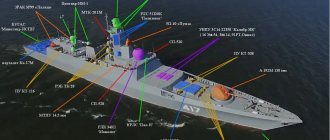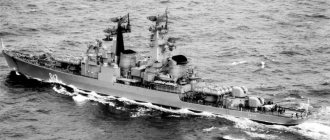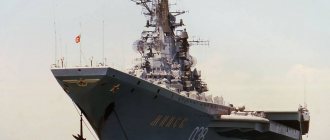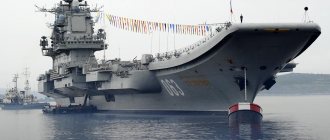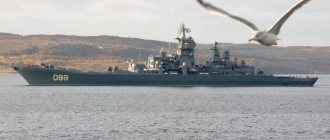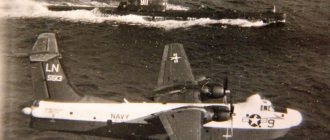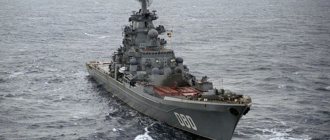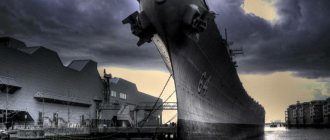Nuclear, heavy, aircraft-carrying. ATAKR project 1143.7 "Ulyanovsk"
Recent months have been relatively fruitful for news about the prospects and various projects of promising Russian aircraft carriers. At the same time, what’s interesting is that we are talking about completely different ships: until recently, the model of the Project 23000 “Storm” aircraft carrier, with a displacement of under 100 thousand tons, which could be equipped with both a nuclear and conventional power plant, was proudly demonstrated to the whole world, and then - information about a relatively light and exclusively non-nuclear ship of the order of 40,000 tons, but with an unconventional orientation towards a “semi-catamaran” hull design, etc. As you can see, the “scatter” in proposals is extremely wide, and there is a natural desire to systematize information about the development of aircraft carriers in the Russian Federation,, if possible, evaluate the concepts that exist today, and understand where military and design thought is moving today regarding aircraft-carrying ships.
However, in order to do this, it is necessary to see the basis, the starting point from which the design of aircraft carriers began in the post-Soviet Russian Federation.
A little history
As is known, at the end of the USSR, domestic industry began to create the nuclear-powered aircraft carrier Ulyanovsk, which, according to the then classification, was listed as a heavy aircraft-carrying cruiser.
Alas, they did not have time to complete it, and the hull of the giant ship was dismantled in the now “independent” Ukraine. But, of course, numerous developments on this ship have been preserved: there are calculations, and sets of drawings, and the results of numerous research works on various components, weapons, assemblies, etc., as well as tactical developments of the military on the use of this ship, and much more. To what was preserved in paper and metal was added practical experience in operating the first and only aircraft-carrying ship in the Russian fleet capable of supporting horizontal take-off and landing jet fighters. We are, of course, talking about the TAKR project 1143.5 “Admiral of the Fleet of the Soviet Union Kuznetsov”.
The author has already talked about the history of the development and operation of the latter in the corresponding series of articles, and there is no point in repeating it. It is only worth recalling that the Kuznetsov concept itself, that is, a non-nuclear aircraft carrier with only one ski-jump without catapults and an air group of limited size, was never what the fleet aspired to.
As is known, the cycle of creating a new type of weapon begins with the awareness of tasks that need to be solved within the framework of the overall strategy, but which cannot be effectively solved by the means at the disposal of the armed forces. Having identified such tasks, the military is able to determine a means to solve them and formulate a tactical and technical specification (TTZ) for such a means. And then comes the work of designers and industry to design and create new weapons. Although, of course, it also happens that the TTZ turns out to be impracticable and, if a compromise cannot be reached between the desires of the military and current capabilities, the project may be terminated. Thus, with the correct order of creation, the latest weapons system should always represent, so to speak, a conscious need of the military, embodied in metal.
Alas, nothing like that happened with Kuznetsov. The tactical and technical characteristics and features of this aircraft carrier were determined not by the needs of the fleet, but by a forced compromise between them and the position of the USSR Minister of Defense D.F. Ustinova. The fleet wanted catapult and nuclear-powered aircraft carriers with a displacement of at least 65-70 thousand tons, and better yet, more. But D.F. Ustinov, believing in the bright future of VTOL aircraft, agreed only to a non-nuclear ship of 45,000 tons: with great difficulty it was possible to convince him to allow increasing the displacement to at least 55,000 tons, and he did not want to hear about catapults.
As a result, in the form of the TAKR 1143.5, the fleet received absolutely not what it wanted and needed, but only what industry could give it within the limits permitted by the all-powerful Minister of Defense at that time. Thus, “Kuznetsov” could not become, and did not become, an adequate response to the tasks facing aircraft-carrying ships of the USSR and the Russian Federation.
Dear readers will probably remember that the author has repeatedly allowed himself to reproach D.F. Ustinov in voluntarism in relation to issues of aircraft-carrying ships of the fleet. Therefore, I consider it my duty to also remind you that Dmitry Fedorovich Ustinov’s services to the country are immeasurable in the literal sense of the word: they have not yet come up with such a measure... Having become, on the recommendation of Lavrenty Pavlovich Beria (and it was not easy to earn a recommendation from him), People’s Commissar of Armaments of the USSR on June 9 1941, he was one of the organizers of the evacuation of the industrial potential of the USSR to the east. And we can safely say that in the chaos of the first year of the war, he and his comrades achieved the literally impossible. After the war, he served as Minister of Armaments and made a lot of efforts to create and develop the USSR missile industry. His service in the military-industrial complex was marked by many achievements and victories; his contribution to the development of the post-war armed forces of the USSR is enormous. Without a doubt, Dmitry Fedorovich Ustinov was a great man... but still, just a man who, as we know, tends to make mistakes. At one time S.O. Makarov quite rightly noted that only those who do nothing make no mistakes, and D.F. Ustinov did an extraordinary amount for his country. And the commitment to VTOL aircraft, in the opinion of the author of this article, was one of the not so many mistakes of this outstanding statesman in every respect.
As you know, Dmitry Fedorovich died untimely on December 20, 1984. And in the same month, the Nevsky PKB was entrusted with the design of a nuclear-powered aircraft carrier with a large displacement and an enlarged aircraft wing. By this time, the future “Kuznetsov” had been on the slipway for 2 years and 4 months, and there were still almost 3 years left before its launch, and almost a year remained before the start of work on the same type TAKR 1143.6, which later became the Chinese “Liaoning”. TTZ for the nuclear-powered aircraft carrier was approved by the Commander-in-Chief of the Navy S.G. Gorshkov. But the design process was not simple, and the preliminary design was reviewed only in April 1986. The project was approved by Admiral of the Fleet V.N. Chernavin and Minister of Shipbuilding Industry I.S. Belousov, and in July of the same year, Nevskoye PKB received an order to prepare and approve a technical project by March 1987. At the same time, the Black Sea Shipyard (ChSZ), where our aircraft carriers were created, was allowed to begin work even before the technical design was approved, and to ensure the unconditional keel of the ship in 1988. This was done: the official keel of the ship took place on November 25, 1988.
As we can see, the procedure for designing a nuclear-powered aircraft carrier in the USSR turned out to be very slow, and, despite all the accumulated “baggage” of knowledge, experience in the development and construction of non-nuclear aircraft carriers of projects 1143.1-1143.5 and many early studies of nuclear-powered ejection aircraft-carrying ships, the laying of the ATAKR “Ulyanovsk” took place later 4 years after the start of work on this ship. It should also be taken into account, of course, that the ChSZ for the laying of Ulyanovsk had to be seriously modernized: the slipways were reconstructed, a new outfitting embankment and a number of additional production facilities were built, which cost approximately 180 million rubles. at the rate of 1991. ChSZ received modern laser and plasma equipment, installed the latest Japanese machines for processing large sheets of metal, as well as the Swedish ESAB prefabricated welding line. The plant mastered a number of new productions, including non-flammable plastics and airborne aircraft lifts, but most importantly, it gained the ability to carry out large-block construction. “Ulyanovsk” was “broken” into 29 blocks, each of which had a mass of up to 1,700 tons (the launching weight of the TAKR was about 32,000 tons), and the installation of the finished blocks was carried out using two 900-ton Swedish-made cranes, each which had its own weight without load of 3,500 tons and a span width of 140 m.
Those same cranes
In other words, ChSZ has turned into a first-class plant for the construction of large-tonnage warships, and even using the latest, “block” method.
Why was Ulyanovsk built at all?
The main tasks for ATAKR, according to the design specifications, were:
1. Giving combat stability to formations of surface ships, strategic missile submarines, and naval missile-carrying aircraft in combat areas. 2. Reflecting enemy carrier-based aircraft attacks and gaining air superiority. 3. Destruction of formations of enemy ships and submarines.
In addition, the auxiliary tasks of ATAKR were listed:
1. Ensuring amphibious landings. 2. Covering enemy missile salvoes with electronic warfare aircraft. 3. Providing long-range radar detection and target designation for diverse fleet forces.
ATAKR and attack aircraft carrier - conceptual differences
As a matter of fact, already from the above-mentioned tasks, the difference in the approach to the construction of aircraft-carrying ships in the USA and the USSR is obvious. America created strike (in the full sense of the word!) aircraft carriers, the main task of which was to strike the coast, including with nuclear weapons. Of course, US strike carriers were also supposed to be engaged in the destruction of the enemy navy, including its surface, submarine and air components, but this task, in essence, was seen only as a necessary step in order to begin the “work” on coastal targets. Thus, the Americans still saw “fleet against shore” as the main form of naval combat.
At the same time, the Soviet ATAKR was initially created for completely different tasks. In essence, Ulyanovsk can be considered as an air defense/anti-aircraft defense aircraft carrier, but first and foremost an air defense aircraft carrier. The Americans believed that carrier-based aircraft would rule the roost in a war at sea, and saw it as the main means of destroying enemy air, surface and submarine forces. In the USSR, the basis of the fleet (not counting SSBNs) was seen to be surface and submarine ships equipped with long-range anti-ship missiles, and land-based naval missile-carrying aircraft, which at that time consisted of Tu-16 and Tu-22 missile carriers of various modifications, including the most advanced Tu-22M3. Thus, in the US concept, the aircraft carrier played a key role in naval warfare, but in the USSR, ATAKR was supposed to perform, in essence, the function of providing air cover for a group of heterogeneous forces, which was supposed to defeat the main forces of the enemy fleet, and thereby decide the outcome of the war on the sea. We will return to this thesis later, but for now let’s look at the design of the Soviet ship.
What happened to our designers and shipbuilders?
"Ulyanovsk" became the largest warship laid down in the USSR.
Its standard displacement was 65,800 tons, the total displacement was 74,900 tons, the maximum displacement was 79,000 tons. The data is given at the time of approval of the ship's design technical specifications by the CPSU Central Committee and the Council of Ministers of the USSR, which took place on October 28, 1987; subsequently they could change slightly. The maximum length of the ship was 321.2 m, according to the waterline - 274 m, the maximum width - 83.9 m, according to the waterline - 40 m. The draft reached 10.6 m. The power plant was four-shaft, provided for the installation of four reactors and was, according to in essence, a modernized power plant for heavy nuclear missile cruisers of the Kirov type. The full speed was 29.5 knots, the economic speed was 18 knots, but there were also auxiliary, reserve boilers running on non-nuclear fuel, the power of which was sufficient to ensure a speed of 10 knots.
Constructive protection
The ship received very serious structural protection, both surface and underwater.
As far as can be understood from the sources, the basis of the surface protection was spaced armor covering the hangar and cellars with weapons and aviation fuel: that is, first there was a screen designed to force the fuse to work, and 3.5 meters behind it was the main layer of armor . For the first time, such armor was used on the Baku aircraft carrier, where its weight was 1,700 tons. As for the PTZ, its width reached 5 m in the thickest places. It must be said that the design of this protection during the design of the ship became the subject of many disputes, and it is not a fact that as a result of “departmental squabbles” the optimal solution was chosen. In any case, one thing is known - the anti-torpedo protection was designed to withstand the explosion of ammunition equivalent to 400 kg of TNT, and this is one and a half times less than on American nuclear-powered aircraft carriers of the Nimitz type, the anti-torpedo protection of which was supposed to protect against 600 kg of TNT.
Active protection
It is often stated that Soviet aircraft carriers, unlike foreign aircraft carriers, had a very powerful air defense system. However, this is an incorrect statement: the fact is that, starting with Baku, our aircraft-carrying ships have not been equipped with not only long-range, but even medium-range air defense systems, without which it is generally impossible to talk about the ship’s developed air defense. But what the Soviet TAKRs could not take away was the strongest missile defense, aimed, of course, at destroying not ballistic, but anti-ship missiles and other ammunition aimed directly at the ship. And in this matter, Ulyanovsk really left behind any aircraft carrier in the world.
Model "Ulyanovsk"
The basis of its air defense was the Kinzhal short-range air defense system, whose missiles could hit air targets traveling at speeds of up to 700 m/sec (that is, up to 2,520 km/h) at a range of no more than 12 km and an altitude of 6 km. It doesn’t seem like much, but it’s quite enough to destroy any anti-ship missile or guided aerial bomb. At the same time, the complex worked fully automatically and had a relatively short reaction time - about 8 seconds against a low-flying target. In practice, this should have meant that by the time the anti-ship missile system approached the maximum firing range, the air defense missile system should already have a ready-made “solution” to defeat it and be in full readiness to use the missile defense system. At the same time, “Ulyanovsk” had 4 fire control radar stations, each of which was capable of “controlling” the firing of 8 missiles at 4 targets in the 60x60 deg sector, and the total ammunition load of the missile defense system was 192 missiles in 24 vertical launchers, grouped into 4 packages of 6 PU.
In addition to the Kinzhal, it was planned to install 8 Kortik air defense systems on the Ulyanovsk, whose missiles had a range of 8 km and an altitude of 3.5 km, and rapid-fire 30-mm cannons - 4 and 3 km, respectively. A feature of the project was that the “Daggers” and “Dirks” were to be controlled by a single control system, monitoring the status of the targets and distributing air defense targets between them.
Of course, modern air defense systems do not create an “impenetrable dome” over a ship - in reality, the destruction of air targets by ship-based means is an extremely complex process, due to the transience of an air attack, low visibility and the relatively high speed of even subsonic missiles. For example, the British Sea Wolf air defense system, created for tasks similar to the Kinzhal, shot down 114-mm shells without problems during exercises, but in practice, during the Falklands conflict, it showed approximately 40% effectiveness against much larger and well-observed shells. targets like subsonic Skyhawk attack aircraft. But there is no doubt that the capabilities of the “Daggers” and “Daggers” of the Ulyanovsk are an order of magnitude superior to the 3 Sea Sparrow air defense systems and 3 20-mm Vulcan-Phalanx installed on the Nimitz aircraft carrier.
In addition to anti-aircraft weapons, the Ulyanovsk was also equipped with the Udav anti-torpedo complex, which was a 10-tube rocket launcher equipped with special anti-torpedo ammunition of various types, and a separate high-frequency sonar was used to detect targets. According to the creators, first the attacking torpedo must collide with traps and deviate from them, and if this does not happen, enter an improvised curtain-minefield created by the “Boa” in the path of the torpedo. It was assumed that the modernized version of the Udav-1M is capable of thwarting the attack of a straight forward unguided torpedo with a probability of 0.9, and a guided torpedo with a probability of 0.76. It is possible, and even very likely, that in combat conditions the real effectiveness of the complex would be much lower, but, in any case, the presence of active anti-torpedo protection, even if imperfect, is noticeably better than its absence.
Electronic warfare equipment
It was planned to install the Sozvezdie-BR jamming and electronic warfare system on the Ulyanovsk. This was the latest system, put into service in 1987, and special attention during its creation and adaptation to the Ulyanovsk was paid to integration into a single circuit along with other systems for protecting the ship from air attack. Unfortunately, the author does not know the exact performance characteristics of the Constellation-BR, but it was supposed to automatically detect the radiation of the ship, classify it and independently select the necessary equipment and modes to counter the emerging threat. In addition, great attention was paid to the compatibility of the ship’s various radio equipment: the fleet was already faced with the problem of many radars, communications equipment, etc. installed on one ship. they simply interfered with each other’s work and could not function at the same time. This deficiency should not have existed at Ulyanovsk.
Environment control tools
In terms of radar, it was initially planned to equip Ulyanovsk with the Mars-Passat system with phased radar, but taking into account the fact that it was dismantled on the Varyag TARK, most likely the same would have happened on Ulyanovsk.
In this case, ATAKR would most likely have received the Forum 2 radar complex, which was new at that time, the basis of which was 2 Podberezovik radars. These radars operated quite effectively at a range of up to 500 km, and, unlike the Mars-Passat, did not require a specialized radar for detecting low-flying targets "Podkat". As for the underwater situation, it was planned to equip the Ulyanovsk with the Zvezda SJSC, but judging by the photographs of the hull under construction, it is possible that the ATAKR would have received the “good old” Polynom.
Here we will take a pause in describing the design of the Ulyanovsk: the following material will be devoted to the capabilities of its air wing, aircraft maintenance, catapults, hangar and strike weapons. In the meantime, let’s try to draw some conclusions from the above.
"Ulyanovsk" and "Nimitz" - similarities and differences
Of all the Soviet warships, the Soviet ATAKR, in terms of its displacement, turned out to be closest to the American superaircraft carrier Nimitz.
However, the different concepts of using ships obviously affected the composition of the equipment and design features of these ships. Today, when discussing the usefulness of aircraft carriers in modern naval combat, two statements regarding aircraft carriers constantly come up. The first is that an aircraft carrier is not self-sufficient and, in a war with an enemy of more or less the same level, requires a significant escort, whose ships have to be taken away from their direct tasks. The second is that domestic TAKRs do not require an escort, since they are quite capable of defending themselves. It must be said that both of these statements are erroneous, but both contain grains of truth.
The statement about the need for a large escort is true only for attack aircraft carriers of the “American” type, which are, in fact, the best floating airfield that can be obtained at a size of under 100 thousand tons, but that’s all. However, this is completely justified within the framework of the American concept of the dominance of carrier-based aviation, which is entrusted with solving the main tasks of “fleet against fleet” and “fleet against shore.” In other words, the Americans propose to solve problems specifically with carrier-based aircraft: in such concepts, separate groups made up of surface ships and not having an aircraft carrier in their composition can be formed only to solve some secondary problems. That is, separate formations of missile cruisers and/or destroyers of the US Navy are not really needed. Carrier strike groups, submarines, which are necessary primarily to fend off an underwater threat, frigates for convoy service - that, in fact, is all that the American fleet needs. Of course, there are also amphibious landing forces, but they operate under the close “tutelage” of the AUG. Thus, the US Navy does not “tear off” destroyers and cruisers to escort aircraft carriers; they build cruisers and destroyers to support the operation of carrier-based aviation, which also solves the tasks that in our fleet were assigned to cruisers and destroyers.
At the same time, of course, a large escort is an integral attribute of an attack aircraft carrier if the latter is opposed by a more or less equal enemy.
At the same time, domestic TARKRs, including the Ulyanovsk, are representatives of a completely different concept; they are just ships supporting the operation of the main forces of the fleet. The USSR Navy was not going to build an ocean-going fleet around carrier-based aircraft; it was going to provide carrier-based aircraft for the operations of its ocean-going (and not only) fleet. Therefore, if, within the framework of the American concept of aircraft-carrying ships, destroyers and cruisers that support the operations of an aircraft carrier perform their main task, for which they were, in fact, built, then within the framework of the Soviet concept, ships ensuring the safety of aircraft carriers are actually thereby distracted from their main tasks.
At the same time, the American aircraft carrier is called upon to solve a wider range of tasks than the Soviet TAKR or even ATAKR. The latter was supposed to either provide zonal air superiority, or air defense of the strike force, as well as anti-aircraft defense, but the carrier-based aircraft of the American “super” was also supposed to solve strike missions. In fact, by eliminating the “strike” function (it was purely auxiliary on Soviet aircraft carriers), our admirals and designers were able to create smaller ships, or better protected ones, or both. As a matter of fact, this is exactly what we see in Ulyanovsk.
Its total displacement was more than 22% inferior to the Nimitz, but its active air defense systems were much stronger. The Ulyanovsk had a torpedo countermeasures system (how effective it was is another question, but it did!), but the Nimitz had nothing of the kind; in addition, the Soviet ship had very powerful structural protection. Alas, it is impossible to compare it with the one that the Nimitz had due to the secrecy of the latter, but it should still be noted that the PTZ of the American ship, apparently, turned out to be better.
As for the installation of a powerful hydroacoustic system, this is a very controversial issue. On the one hand, of course, the equipment of the Polynom SJSC weighed about 800 tons, which could be used to increase the number of air wings of the ship, or the quality of its use. But on the other hand, the presence of a powerful GAK on ATAKR significantly increased its situational awareness and thereby reduced the number of ships needed for its direct escort, which means freeing up additional ships to carry out combat missions.
At the same time, it would be completely wrong to consider the domestic TAKR or ATAKR of the USSR era as a ship capable of conducting combat operations completely independently. Firstly, it is simply not intended for this, because its role is air defense and anti-aircraft defense, but not the independent destruction of enemy surface ship groups; however, this issue will be discussed in more detail only in the next article. And secondly, he still needs an escort - another question is that thanks to strong (although not having a “long arm”) air defense, powerful electronic warfare, etc. its escort may be significantly smaller than that of an American aircraft carrier.
To be continued…
Project 11437 - heavy aircraft-carrying cruiser "Ulyanovsk"
Design work on the first full-fledged aircraft carrier with a nuclear power plant began in 1973.
the development of the Project 1153 aircraft carrier, which involved the deployment of catapult-launched aircraft - Mig-23K fighters and Su-25K attack aircraft. The ship's displacement was 80,000 tons and the air group size was 70 aircraft. The death of Defense Minister Marshal Grechko, who supported this project, and the assumption of this post by Marshal Ustinov, who was not a supporter of it, led to the suspension and cancellation of its implementation in 1983.
The development of the Project 1143.7 Ulyanovsk heavy aircraft-carrying cruiser began at the Nevsky Design Bureau in 1984 under the leadership of L.V. Belov (later replaced by Yu.M. Varfolomeev). The design took into account the experience of developing the Project 1160 aircraft carrier. It was planned to build 4 ships. On October 4, 1988, the lead "Ulyanovsk" (serial number 107) was included in the lists of Navy ships and on November 25 was laid down at the Black Sea shipyard No. 444 in Nikolaev. Commissioning was planned for December 1995.
The Ulyanovsk TAVKR differed from previous TAVKRs in its nuclear power plant, increased size of the flight deck, ski-jump (landing angle 14°) and two steam catapults (90 m long). The ship had a high-sided hull made of steel using a longitudinal frame system. The hull was divided into 20 waterproof compartments. The superstructure (“island”) was located on the starboard side. The reservation system included box-shaped protection for ammunition magazines and anti-torpedo protection. The power plant consisted of 4 turbines and 4 reactors with a thermal power of 305 MW each. Auxiliary boilers were provided, capable of providing the ship with a speed of 10 knots when the reactors were shut down. The source of electricity is a generator with a capacity of 27,000 kW. Up to 70 aircraft and helicopters could be based on board: 20 MiG-29K, 25 Su-33, 8 Yak-44, 15 Ka-27PL, 2 Ka-27PS. To store the aircraft below deck there was a hangar measuring 175x32x7.9 m. They were lifted to the flight deck using 3 lifts with a lifting capacity of 50 tons (2 on the starboard side and 1 on the left). The Luna optical landing system was located in the aft part.
The ship's armament was to consist of 16 Granit anti-ship missile launchers, 4 SM-9 air defense missile systems, 8 Kortik (later Broadsword) launchers, 2 RBU-12000 rocket launchers, 8 six-barreled 30-mm AK artillery mounts -630M. The radio equipment included: BIUS "Tron-Diplomant", multifunctional complex "Mars-Passat", three-dimensional radar "Podberezovik", radar for detecting low-flying targets "Podkat-M", navigation complex "Andromeda", space communication system "Centaur", The Resistor flight control radar and the Lawn fighter guidance system, the Sozvezdie-BR electronic warfare station, and the Zvezda-M1 sonar system.
